|
Peer-to-Peer Economic Activity Possible with Blockchain
|
|
|
|
|
|
Tharp's Thoughts
Inbox Mentoring
|
|
|
|
|
|
|
|
-
Feature: June Update on Cryptocurrencies, by Van K. Tharp, Ph.D.
-
Workshops: Use Combo Discounts to Save on Back-to-Back Events
-
Tips: Tip, by D.R. Barton, Jr.
-
-
GDPR: Read Our GDPR Statement
|

|
|
If you've ever had an interest in Forex Trading you now have two opportunities this year to take both Forex workshops (Forex Trading and Forex Live) and learn from an expert in this field. Not only are we offering these workshops at our facility in Cary, NC this August, but we are also offering them this October in London, England along with a host of Van's other groundbreaking workshops! Be sure to use a combo discount if attending more than one workshop to pay less for each event!
If you've had a taste of Gabriel's Forex systems in his e-learning course "Forex Trading: The Busted Breakout System" you will have the opportunity to not only learn two more of his Forex Systems but receive follow up coaching that provides you with his invaluable support after taking this workshop. Follow that up with his Live Forex Trading and learn "hands on" just how well these systems work with Gabriel's guidance. Plus, if you've taken his e-learning course, you can deduct $600 off of your payment for the workshop. Just contact us at [email protected]
If you haven't purchased the e-learning course you can; this is a great way for you to get a full-steam head-start and walk through the workshop door already understanding the system well. You will then have the opportunity to ask Gabriel anything you need. Purchase the e-learning course here. Scroll down to our workshop section to learn
more!
|
|
Hear from students who have taken both Forex Trading Systems and Live Forex
workshops to hear about their experiences!
|
|
|
|
June Update on Cryptocurrencies
by Van K. Tharp, Ph.D.
|
|
|
|
|
The crypto market skyrocketed in the final months of 2017. By December 17th, BTC (bitcoin) had climbed to nearly $20,000 from $14,000 on December 1st. Around January 1st, BTC had fallen back to about $14,000 and the market capitalization of all cryptocurrencies was about $600 billion (USD). Since then, the crypto market has crashed from the all-time highs. There have been a few “dead-cat” bounces but the prices of cryptos in general, will continue to go down. Now we are at mid-June and I am presenting our Cryptoassets and Blockchain workshop for our Super Traders this week.
In the chart below, I am changing the cryptoassets that we follow regularly. Bitcoin is basically a first generation crypto, so we will follow it as long as it exists. Ether is a second-generation crypto that allows for smart contracts so we will follow that as a primary crypto as well. We will follow Ether's Chinese equivalent, Neo. In addition, we will follow third generation crypto assets Miota (IOTA) and Skycoin. These 3rd generation coins are important because they combine smart contracts with huge scalability and zero transaction cost. Just because something is a third generation crypto, however, does not mean it will survive and dominate earlier generation cryptos.
Finally, I have added the Jan 15, 2017 prices to put this crash into perspective.
|
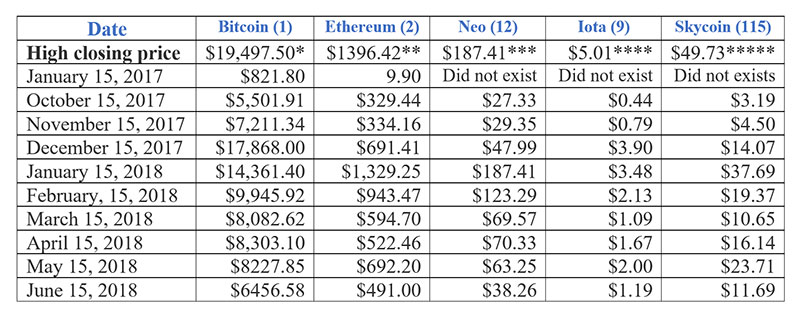
|
|
Date of the All-Time High Closes
*Dec 16, 2017 ** Jan 13, 2018 ***Jan 15, 2018 **** Dec 8, 2017 ***** Dec 29, 2017
I’m adding a second table to these updates which will include the market cap for cryptocurrencies, the percentage of Bitcoin of the total market cap, the percent of market cap for the top five cryptocurrencies, and the number of cryptocurrencies listed.
|

|
|
The data in both of these tables comes from www.coinmarketcap.com.
Notice that the market cap on June 15 has fallen 66.1% since January 8th when we first started doing the crypto monthly update.
Yahoo Finance now lists prices for about 100 cryptocurrencies so I can run some of my normal studies on the data. I’m only looking at those coins for which there is at least 100 days of data – which does not include every crypto in the top 100 list by market cap.
These cryptos had the top Market SQN 100 scores on June 15, 2018 – At the moment, there are two crypto assets with SQN 100 scores over 1.0 – Binance Coin (which is the token of the Binance exchange) and a coin called ATM which ranks about 424 in market cap.
|
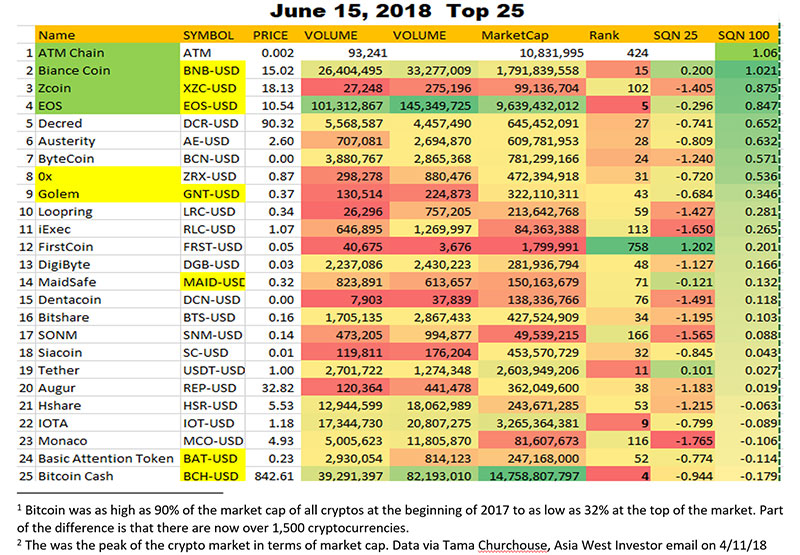
|
|
We have four coins with a Market SQN (100 days) over 0.7 – meaning that we call them bullish. And in the top 25 Market SQN scores, only 20 of the coins have a positive SQN. The following coins, however, have been staying in the top 10 despite the crash in the crypto market: BNB, GNT, EOS, XZC, OX, Decred, and Austerity.
Last month 44 of the 95 cryptos ranked had positive numbers. This month we are down to 20 positive scores.
We are also working on a crypto screener somewhat like our world market model for ETFs. Here, I have a different listing for the top 15 and the bottom 15. In the next few months, we expect to integrate this information, but for now, I’ll just report both sets of data. Right now the top one comes from Yahoo and the bottom one comes from coinmarketcap.com.
Here are the top and bottom 15 cryptos by Market SQN scores in our other screener.
|
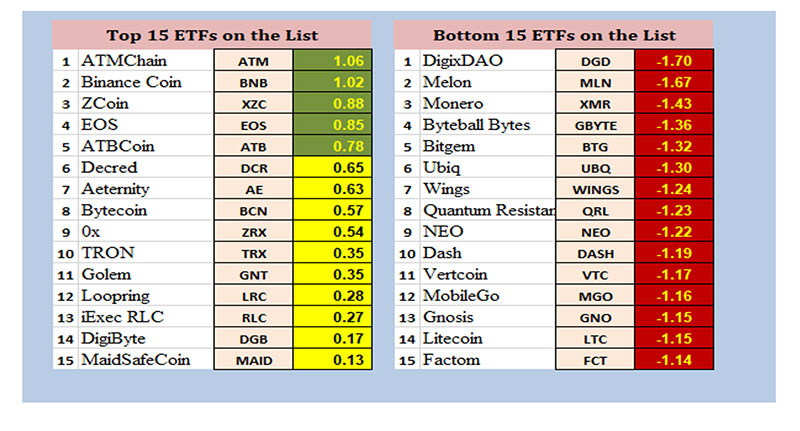
|
|
We have also classified the coins by type. We expect to improve the classification and listings over time.
Here is the first set of classifications. ETH also fits into the USD Exchangeable category while LTC (right now at least) is not — at least on Coinbase where most US Citizens exchange US Dollars for cryptos.
|
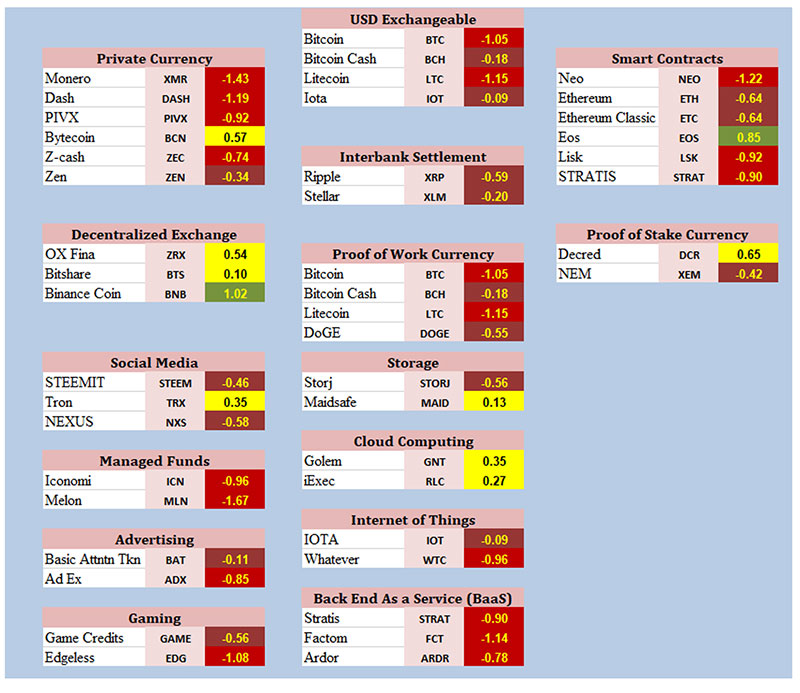
|
|
Most of the primary cryptos that we follow are near their yearly lows. We don’t have an overall crypto index but if we did have one, I’m sure the market type would be bear volatile. The purpose of this report is just to give you a status quo for the cryptoasset markets, not to predict. The market type is definitely bear for now and we’d expect that to continue for a while.
In my opinion, blockchain, the primary technology behind cryptoassets, is not just the next revolution in computers. It’s not just part of web 3.0. Blockchain really is an institutional revolution. Since the industrial revolution, the economic model has continued to be large institutions running the show (governments and huge corporations). The model has worked fairly well and allowed humanity to make great progress. But it has also ensured that the rich get richer and very little impacted lives at the fringes. Karl Marks criticized Capitalism for being unfair to the workers, however, his alternative was a huge Communist-style centralized government which basically
stifled the good things about Capitalism.
The blockchain, however, has industrial area economic models. Why? Because through technology, we have the opportunity to replace large centralized organizations with decentralized peer to peer networks. Most Americans are probably not aware that about 4 billion people in the world earn less than $2 per day and nearly all of them no bank accounts. It's basically impossible for them to participate in the economic prosperity of the world.
The blockchain is exciting because now each of them can put the money that they do have on the blockchain and start peer-to-peer economic activity in which they get paid for what they do at a fair rate. Before this could happen, however, there are huge hurdles to overcome. For example, they’d have to have access to a computer (or smartphone) and know how to use it. What are the chances of that happening for the average person who makes less than $2/day?
Nevertheless, let’s just look at how poor countries can prosper from the blockchain. Let’s say that a business in Vietnam wants to purchase some resources from Nigeria. In order for the transaction to take place right now, a lot of middlemen need to intervene to make sure it can happen. For example, Vietnamese Dong needs to be exchanged for US Dollars and are then exchanges for Nigerian pounds. This actually is a very slow process and the transaction fees might be as high as 20%. Though the blockchain, however, immediate transactions could take place using the local currencies and there would be no bank in between to take away 20% of those
transfers.
There is some good news because the SEC (Securities and Exchange Commission) recently ruled that ETH is not a security. This will pave the way for an ETH futures contract which is already planned. The chairman of the SEC said that all cryptocurrencies are not securities. He also said that if a group conducts an ICO and they promise you a return for your money, then the SEC will consider that coin a security. That criteria fits most ICOs so that's one reason that most ICOs are not being offered in the United States and most ICOs exclude US Citizens from participating. In fact, many foreign crypto exchanges also exclude US Citizens.
The big concern is for all of the ETH platform projects. Executives from many of the 1,400 ETH based projects have been selling ETH to pay for legal fees in dealing with the SEC trying to regulate them as a security. While that remains undecided, the IRS treats all crypto positions as property for taxation purposes. That has been a huge downward pressure on that market. Most of the ETH projects are in their alpha phase so they are not well developed at all and might be said to be worthless. The price of ETH already reflects what’s going on. It will take time for the killer apps being developed on the ETH platform to really come to fruition and the SEC will consider most
of them to be a security.
I heard two interesting pieces of news recently:
The US crypto exchange Bittrex is making great strides. First, they have developed a legitimate stable coin for the US Dollar. It’s not a scam like Tether.
But most interestingly, Bittrex plans to allow $US dollar crypto trades directly, that way customers may not have to go through Coinbase to get into the crypto markets. Bittrex is a US exchange, but the regulators must be on top of what is going on. They are already allowing corporate customers from CA, NY, WA, and MT and a few international customers to do such trades. They will roll this out in phases. And at first, only major cryptos will be traded with the US Dollar.
The Bottom Line:
|
|
1) I don’t know what Bitcoin is going to do in the next six months. In fact, I don’t even like BTC because it is too slow to send, too expensive to send, and it it’s currently using up $1.5 billion dollars’ worth of our energy to produce. All this for a coin with a market cap right now of $112 billion.
2) I don’t know if the second and third generation crypto assets mentioned in this report will be the primary vehicles of the future. For those that survive, I’m sure there will be lots of changes through forks in the tokens.
3) I am convinced that the blockchain is absolutely here to stay and that the revolution taking place will be the biggest in my lifetime. It will change everything.
4) 2018 is currently a difficult year because of the issue of what is a security versus the IRS (and most world taxing authorities,) to treat all cryptoassets as property so that a tax event occurs as soon as you sell it. That means if you have Bitcoin in a debit card and you use the card to buy coffee, you have created a tax event. Bitcoin needs the $600 rule that applies to FOREX before it can become a major alternative to other currencies.
5) In addition, while crypto projects are in their infancy and they have to deal with the SEC, it will be difficult for them to explode. When small companies have to deal with legal issues, it is very difficult for them to innovate.
6) Finally, many of the best traders/investors in the world became that way because of a huge edge and because they were in the right place at the right time. Well, one emerging edge right now is understanding how blockchain technology will affect whole industries and eventually, nearly every company in some way. That’s why I’m doing a workshop right now for our Super Traders on the topic.
|
|
Until the July 15th Crypto Update, this is Van Tharp.
|
|
|
|
|
|
About the Author: Trading coach, and author, Dr. Van K. Tharp is widely recognized for his best-selling books and his outstanding Peak Performance Home Study program - a highly regarded classic that is suitable for all levels of traders and investors. You can learn more about Van Tharp www.vantharp.com.
|
|
|
|
|
|
|
|
|
Instructor Kim Andersson discusses some of the objectives of her upcoming workshop "Sideways Market Strategies" in the video below. Attend Forex and Sideways back-to-back in August to
save up to $1,000!
|
|
|
|
The U.S. Index That Doesn’t Think the Bull Market is Over
by D.R. Barton, Jr.
|
|
|
|
|
The brinksmanship of trade wars once again has the markets on edge. The last few salvos in the potential clash saw the markets drop and then quickly recover as both sides moderated their stances.
If that’s the case this time around (as we’ve seen in news coming from German automakers and others), we could get another push higher the U.S. indexes.
To be clear, a trade war is one of the few events (at least of the ones with a reasonable probability of happening) that could derail this bull market. However, the relationships of the indexes and their reaction to the overnight tariff troubles tell of a market that’s expecting more upside.
As I write this Wednesday morning (June 20), here’s the price reaction of the big four indexes since Thursday’s close (the latest round of tariff volleys started Thursday evening):
Dow: -2.2%
S&P 500: -1.0%
Nasdaq: -0.4%
Russell: +1.0%
As they would sing on the children’s education show Sesame Street, “One of these things is not like the other…”.
In general, the Dow (blue chip stocks) and the S&P 500 (large cap index) are the “risk-off” indexes – containing the bigger, traditionally lower risk stocks. The Nasdaq (tech stocks) and Russell 2000 (small-cap stocks) are the “risk-on” indexes with higher growth potential and bigger risk potential in down markets. They’re the indexes traders and investors turn to when they feel good about the market’s prospects and don’t mind the extra potential risk.
So if the market participants were worried about a long-term protracted trade war, why are they liking the riskier indexes more?
And that’s not all, the Russell 2000 has been consistently outperforming the S&P 500 since the end of February 2018 -- as we can see on this chart:
|
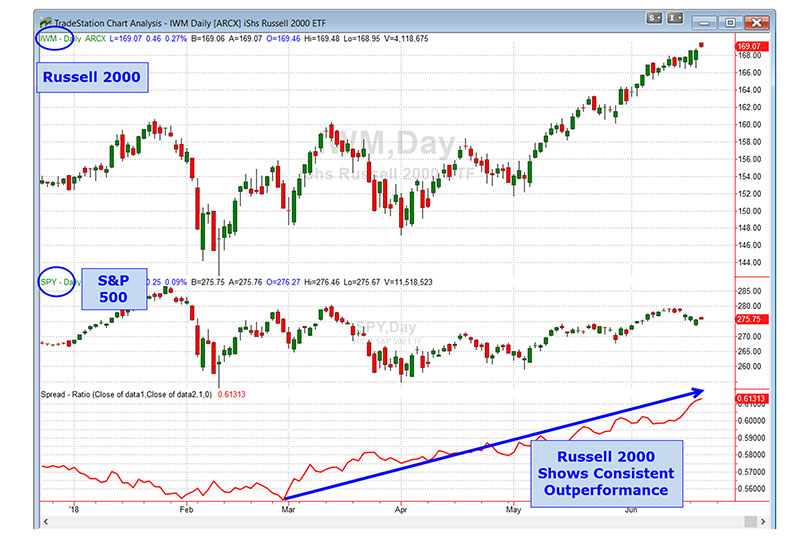
|
|
The red line at the bottom of the chart is simply the ratio of the top graph (Russell 2000) divided by the middle graph (S&P 500).
It means that price of the small-cap Russell 2000 has been strongly and persistently outperforming the large-cap stocks for the past 3 ½ months. And this “risk on” behavior shows that investors are still looking for growth opportunities instead of being defensive with their investments.
One other tariff-related comment. Traders and investors are clearly concerned that a full-blown trade war will break out. With the S&P down barely 1% on this recent barrage of trade announcements, it seems the market is pricing in a more muted reconciliation in the end and sees these recent announcements more as posturing than actual enforcement actions.
Great trading and God bless you,
D. R.
|
|
|
|
|
|
About the Author: A passion for the systematic approach to the markets and lifelong love of teaching and learning have propelled D.R. Barton, Jr. to the top of the investment and trading arena. He is a regularly featured analyst on Fox Business Networks’ Varney & Co. TV show (catch him Tuesdays at 9:30 a.m. EST), on Bloomberg Radio Taking Stock and MarketWatch's Money Life Show. He is also a regular guest analyst on CNBC World, CNBC's Closing Bell, Fox Business Network’s Cavuto Coast to Coast and Making Money with Charles Payne and the China Global Television Network. His articles have appeared on SmartMoney.com, MarketWatch.com and Financial Advisor magazine. You may contact D.R. at "drbarton" at
"vantharp.com."
|
|
|
|
|
|
|
|
|
Two Dates - Two Countries
Forex Trading Systems and Forex Live Trading
♦ August 11-13 (Forex Trading) - August 14-15 (Fx Live) in CARY, NC
♦ October 20-22 (Forex Trading) - October 23-24 (Fx Live) in LONDON, ENGLAND
|
|
If you aren’t trading Forex in any way right now, here are the top ten reasons why you should consider it:
1. Have you ever been stuck in a position overnight dreading the large gap at the open?
FX is a very large, very liquid market that trades around the clock so opening gaps are effectively eliminated.
2. How often do you have trouble finding a decent trend?
You can always find good trends in FX because oceans of money are flowing between countries as the relative strength of their economies changes constantly.
3. What if you can only trade for the part of the day that doesn’t work well (or doesn’t work at all) for your market?
Trade FX at a time of the day that fits your schedule best.
4. Are you tired of slippage, partial fills, and running up large trading commissions and fees?
You get low cost and efficient order management in FX.
5. Do you ever enter a position that just doesn't seem to follow the pattern you are trading?
FX makes an ideal market for charting and pattern trading from 1min to Monthly charts because of its consistency.
6. Do most of your trading candidates seem to move together — and not offer setups on a frequent enough interval?
Most currency pair prices move independently.
7. Does your net worth decrease when your home country currency weakens?
FX offers the ultimate way to diversify your net worth and hedge your risk to it. Hedge a weakening currency or profit by trading it rather than simply watching it fall.
8. How often do large, swift price moves surprise you and you can’t "get out of the way" quickly enough?
Price movements in FX tend to be smoother than in most other markets which makes FX the ideal asset class to learn how to trade it.
9. Do you think you understand Tharp Think principles and wonder how to put them into use?
Tharp Think principles apply better to FX than with any other asset class.
10. Whether you are a long term trend follower, a fundamentals analyst, or a pure technician, does your preferred approach not work so well in your preferred market? Do so-called successful strategies not seem to fit you?
Out of any asset class, FX allows you the most flexibility to choose a trading style and a timeframe that fits you best.
Given this powerful list, why aren’t you trading Forex or at least planning to?—Gabriel
|
|
|
|
Presented by Van Tharp,
with RJ Hixson
|
|
|
|
|
|
|
|
|
|
|
July 17-19
Tuesday-Thursday
|
|
|
|
|
|
|
|
Special Price Offer, July Only
Peak Performance 101 in July is a very important workshop to put on your calendar if you want to qualify for and apply to the Super Trader program. Why? The price for the program goes up on August 1, 2018 and Dr. Tharp has additional discount offers for those who attend in July.
|
|
Learn the Mental Secrets for Getting What You Really Want in Peak 204!
The material covered in this course will be information you can use to improve your life and your effectiveness.
The material will also be cutting-edge. It's not the sort of thing you can learn anywhere else. This workshop will probably be the only place that you could possibly pick up all of this unique information together.
Most importantly, the material will be presented in a practical way with plenty of exercises so you can incorporate the strategies you learn right into your daily life. When you leave the workshop, the most important strategies will become part of you.
Remember, this is a very exclusive workshop. It requires that you’ve attended Peak 101. We will be doing a lot of work with sub-modalities so you should at least have a little experience working with submodalities.
In addition, you can expect highly motivated, like-minded, success-oriented traders like you to join you in this incredible experiential workshop.
|
|
|
|
Presented by Gabriel Grammatidis
|
|
|
|
August 11-13
Saturday-Monday
|
|
|
|
|
|
|
|
Presented by Gabriel Grammatidis
|
|
|
|
August 14-15
Tuesday-Wednesday
|
|
|
|
|
|
|
|
Presented by Kim Andersson
Profit When Price Goes Nowhere: How to Successfully Trade Sideways Markets In Every Time Frame
|
|
|
|
August 17-19
Friday-Sunday
|
|
|
|
|
|
|
|
No matter what time frame you trade or what method you use to measure them, Sideways markets happen between 59% and 65% of the time! And even though they appear a majority of the time, Sideways markets are rarely discussed, even in professional trading circles. Until now....
Kim is a 2015 Super Trader Graduate from VTI. Before she completed her studies with us, she had earned a Masters in Systems Engineering - which is no small feat! She has also served as an IT Security Consultant to the Pentagon, while also performing her duties with the Canadian Air Force.
She currently works as a Cyber Security Engineer at Lockheed Martin/Leidos and trades her systems part-time, finding a work/life balance that works for her and her family.
With over 1,850 trades completed, Kim has the solutions AND THE EXPERIENCE to lead you in a Sideways Market.
She has put in a tremendous amount of work and effort in to bringing this unique training out into the open. Originally designed with our Super Traders in mind, Kim and I decided to develop this material so that all traders or investors could come to the workshop and take home this critical information on this underappreciated market type.
This means that enrollment is limited as many seats will be filled with students from our elite Super Trader program.
If you think you are ready for a fast-paced, hands-on event hosted by an instructor, 100% dedicated to teaching you how to effectively trade Sideways markets, make plans to join us this August 11th-13th.
|
|
|
|
Presented by R. J. Hixson
|
|
|
|
September 14-16
Friday-Sunday
|
|
|
|
|
|
|
|
Presented by Libby Adams and RJ HIxson
|
|
|
|
September 18-21
Tuesday-Friday
|
|
|
|
|
|
|
The How to Develop Winning Systems Workshop teaches you what you need to know to develop your own system. The material you will learn is not market or time-frame specific. So whether you trade stocks, futures, currencies, gold, etc., or
whether you place 50 trades per day or 50 trades per year, you will learn all of the components that work in any system. With this knowledge you can both modify existing systems to fit you or the market type better, or master your own system development.
Two locations to choose from, Cary, NC in September and London, England in October!
The Peak Performance 202 Workshop is divided into three sections covering 4 days:
- How you are programmed to follow the path that others want you to follow.
- The various games that you play.
- Personal reinvention.
Past participants say this was one of the most significant workshops they had ever attended. You will leave with a new sense of purpose and a new direction and a support team behind them.
|
|
|
|
Presented by Van Tharp,
with RJ Hixson
|
|
|
|
October 12-14
Friday-Sunday
|
|
|
|
|
|
|
|
|
|
October 16-18
Tuesday-Thursday
|
|
|
|
|
|
|
|
Presented by Gabriel Grammatidis
|
|
|
|
October 20-22
Saturday-Monday
|
|
|
|
|
|
|
|
Presented by Gabriel Grammatidis
|
|
|
|
October 23-24
Tuesday-Wednesday
|
|
|
|
|
|
|
|
|
|
October 26-28
Friday-Sunday
|
|
|
|
|
|
|
|
|
|
|
|
November 9-11
Friday-Sunday
|
|
|
|
|
|
|
|
|
|
November 12-13
Monday-Tuesday
|
|
|
|
|
|
|
|
Exciting New Work from Van Tharp
|
|
|
|
November
15-17
Thursday-Saturday
|
|
|
|
|
|
|
|
|
|
FREE Book!
We pay for the book, you just pay for shipping.
When you add the free book to an item already being shipped there is generally no extra shipping charge (of course, depending on your location).
Read Van’s Latest Book —
TRADING BEYOND THE MATRIX
The Red Pill for Traders and Investors
Eleven traders tell their stories about transforming
their trading results and lives, in this 400 plus page book.
Below is a brief video on how powerful this book is to traders.
|
|
|
|
GDPR COMPLIANCE:
The European Union General Data Protection Regulation (GDPR) went into effect on May 25, 2018 and is designed to allow individuals to more effectively control their personal data. At The Van Tharp Institute (IITM, INC) , client information is private and confidential; we do not share, trade, or sell to anyone. We never have. You may ask us at any time to unsubscribe. We keep your information safe. If you’d like access to your information just ask. You receive this information from us because you opted into the Van Tharp newsletter either through direct registration or registration through our Tharp Trader Test.
You may opt out below.
This email was sent by by Van Tharp Institute
102A Commonwealth Court | Cary | NC | 27511
\
Cary, NC Workshop Information
For a list of nearby hotels for our Cary, North Carolina locations,
click here.
Book your flight arriving to the Raleigh-Durham International Airport (RDU).
When traveling to a three-day course, it's best to arrive the evening before.
To help determine your arrival and departure times, see:
Questions? Click Here to Ask Van...
CONTACT US
If you no longer wish to receive our email updates, click the unsubscribe link in the bottom-left corner of this email.
This is a supplement to our subscription based newsletter, Tharp's Thoughts.
800-385-4486 * 919-466-0043 * Fax 919-466-0408
|
|
|
|
|